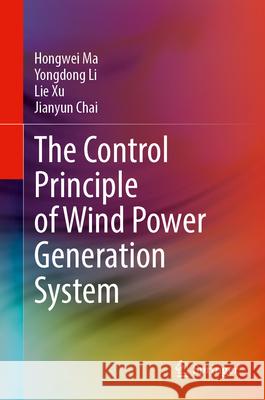The Control Principle of Wind Power Generation System » książka



The Control Principle of Wind Power Generation System
ISBN-13: 9789819960828 / Angielski
The Control Principle of Wind Power Generation System
ISBN-13: 9789819960828 / Angielski
(netto: 536,72 VAT: 5%)
Najniższa cena z 30 dni: 539,74
ok. 22 dni roboczych
Dostawa w 2026 r.
Darmowa dostawa!
Chapter 1 Introduction.- Chapter 2 Mathematical Models and Modelling Methods for the DFIG-based Wind Power System.- Chapter 3 Control Strategies for the DFIG-based Wind Power System under Ideal Grid Conditions.- Chapter 4 Operational Characteristics of the DFIG-based Wind Power System under Non-ideal Grid Conditions.- Chapter 5 Low-voltage Ride-through Technologies for the DFIG-based Wind Power System.
Dr. Hongwei Ma received the B.S. degree in electrical engineering from Harbin Institute of Technology, Harbin, China, in 2008, and the Ph.D. degree in electrical engineering from Tsinghua University, Beijing, China, in 2013. He was a visiting scholar at School of Engineering, University of Wisconsin—Madison, USA, in 2015, and is currently a researcher and a master supervisor with School of Automation, Beijing Institute of Technology, Beijing, China. His current research interests include renewable energy, energy storage, power electronics, motor drives, and optimization control. He has authored or co-authored more than 20 books, chapters, journal articles, and conference papers. He is a IEEE and IES member and a reviewer for some international journals and has chaired several international conferences’ sessions.
Professor Yongdong Li received the B.S. degree in electrical engineering from Harbin Institute of Technology, Harbin, China, in 1982 and the M.S. and Ph.D. degrees in electrical engineering from the Department of Electrical Engineering, Institut National Polytechnique de Toulouse, Toulouse, France, in 1984 and 1987, respectively. He is currently a professor in the Department of Electrical Engineering, Tsinghua University, Beijing, China, also a guest professor with Institut National Polytechnique de Toulous, France, and Harbin Institute of Technology, China, a distinguished professor of Delta Scholar Program, a IET fellow, and a IEEE senior member. His research interests include the high capacity power electronics converter and its application on high-voltage variable frequency speed regulation, renewable energy generation, electrical drive for high-speed railway, and integrated full electrical propulsion for marine. He has authored or co-authored more than 300 books, chapters, journal articles, and conference papers. He is working as the vice-chair at Research Center of Power Electronics and the vice-president at Institute of New Concept Vehicle, Tsinghua University.
Associate Professor Lie Xu received the B.S. degree in electrical and electronics engineering from Beijing University of Aeronautics and Astronautics, Beijing, China, in 2003, and the M.S. and Ph.D. degrees in electrical and electronics engineering from the University of Nottingham, Nottingham, UK, in 2004 and 2008, respectively. From 2008 to 2010, he was a research fellow in the Department of Electrical and Electronics Engineering, the University of Nottingham. He is currently an associate professor in the Department of Electrical Engineering, Tsinghua University, Beijing, China. His research interests include multilevel converter, direct AC–AC power conversion, and multilevel matrix converter. He has authored or co-authored more than 40 books, chapters, journal articles, and conference papers.
Professor Jianyun Chai received the B.S. and Ph.D. degrees in electrical engineering from Tsinghua University, Beijing, China, in 1984 and 1989, respectively. He has eight years of experience in industry as an engineer. He is currently a professor in the Department of Electrical Engineering, Tsinghua University. His research interests include renewable energy power systems, design and control of special motors and generators, and power electronic drive systems.The book focuses on wind power generation systems. The control strategies have been addressed not only on ideal grid conditions but also on non-ideal grid conditions, which are more common in practice, such as kinds of asymmetrical grid conditions and weak grid conditions. This is achieved by providing in-depth study on a number of major topics such as mathematical models, modeling methods, dynamic characteristics on ideal grid condition and non-ideal grid conditions, advanced control strategies, and novel topologies.
The comprehensive and systematic elaboration of wind power systems by a large number of original simulations and experimental results from the authors’ research group is one of the major features of the book, which is particularly suited for readers who are interested in learning practical solutions to wind power systems. The book benefits researchers, engineers, graduate students, and senior undergraduate students in fields of electrical engineering, power electronics, wind power generation, etc.
1997-2025 DolnySlask.com Agencja Internetowa
KrainaKsiazek.PL - Księgarnia Internetowa









